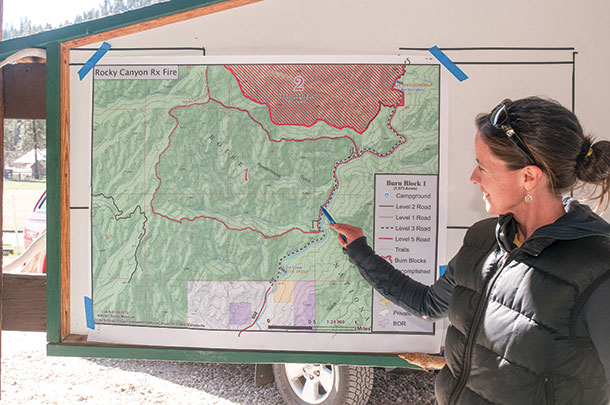Choosing to burn won’t break the bank, but harnessing fire takes more work than just lighting a match. There are many benefits to prescribed fires, and following the correct plans will save you from getting burned.
“Prescribed burns aren’t just for the sake of lighting a fire,” United States Forest Service (USFS) national fuels manager Frankie Romero says. “It’s lighting a fire with a specific goal in mind for that chunk of land.”
Reasons behind burning
Allen Rasmussen, the dean of the Dick and Mary Lewis Kleberg College of Agriculture, Natural Resources and Human Sciences at Texas A&M University – Kingsville, says there are three main reasons to apply a prescribed burn: to change the vegetation composition, to manage the habitat and to remove shrub and replace with grass.
“It basically is a mechanism to manage the habitat,” Rasmussen says. “A way to change the vegetation so it meets management objectives, which is allowing forage for cattle.”
Prescribed burns bring diversity to habitats and can be done in entire pastures or in certain targeted areas.
Utah rancher Darrell Johnson noticed the wildfires going through his state were benefiting the land more than damaging it.
“At first we saw what happened with the wildfires and the juniper,” Johnson says. “We saw a huge growth of grass where those areas were burned.”
After realizing the rejuvenating power of fire, Johnson decided to make it one of his primary management methods.
“We have burned the land and reseeded it,” Johnson says. “Now it’s in excellent condition.”
In recent years, federal regulations have increased on prescribed burning and, currently, several requirements have to be met. Johnson hasn’t conducted a prescribed burn in a few years, but he says it’s one of the most effective methods.
“Our burns were extremely successful,” Johnson says. “I thought it was the best tool we had to remove junipers from rangeland.”
What’s happening underneath the flames
When a wildfire sweeps through the brush, it destroys everything in its path. But in a few years, regrowth is evident because the fire acts as a fertilizing agent.
“The reason for that is: The fire allows the soil temperatures to increase, which increases the microbial activity,” Rasmussen says, “which breaks down organic matter, which then provides nitrogen – and then you get a fertilization effect.”
The growth and nutrient value of vegetation is increased after a prescribed burn is applied. Rasmussen even says fire can provide management tools a herbicide cannot.
“If I burn in the summer in Texas, I can do a great job controlling a lot of brush species, and I also increase the insects,” Rasmussen says. “By increasing the insects, it actually benefits other areas.”
Certain parts of the country will determine how often prescribed burns are applied. According to Rasmussen, in the Flint Hills of Kansas, ranchers burn once a year to increase vegetation nutrition. In the drier parts of the county, burning will be done once every five, 10 or even 25 years.
“Figure out what you are trying to do,” Rasmussen says, “then it’s pretty easy to see if fire works.”
Planning is key
Even though lighting a match and throwing it onto a field seems to be a quick and easy option, it is not the best way to go about it. There are many aspects and components to consider when planning a prescribed burn.
Pat Shaver, who worked with the Natural Resources Conservation Service (NRCS) for 40 years as the national applied fire ecologist, says to make sure to identify which grazing management goals are not being met before considering a prescribed burn.
“Always ask questions like ‘Is this already the right amount of fuel?’ Or ‘Is my grazing schedule OK?’” Shaver says. “It all goes to back to the planning process of identifying what is already there and what the objectives are and how the objectives can be met.”
Shaver is now an animal and rangeland science instructor at Oregon State. Before he retired from the NRCS, he worked with ranchers and government employees to certify and train for prescribed burning. He has orchestrated many plans for burning.

“Wind speeds, humidity and forecast of the planned day are some of the few weather conditions that are considered and planned around,” Shaver says. “And having proper equipment and people is very important.”
Each state and county has different laws and certifications concerning prescribed burns. State and federal agencies, such as the NRCS, do fire trainings and will help ranchers carry out prescribed burns. Other agencies, such as the USFS, assist ranchers when private land is adjacent to federal land or permitees request help.
“We are certainly looking for opportunities to treat forest service grounds,” Romero says. “So the land is more productive.”
Johnson advises ranchers to get permitted by state and county authorities. In past experiences, local and state crews have assisted him with conducting prescribed burns.
“Fire is so much cheaper than normal removal,” Johnson says. “People will always help you.”
Number one priority
Fire initially seems like a cheap alternative to remove invasive species, but according to Rasmussen, the opportunity cost is where it gets expensive.
“A lot of people will talk about how cheap fire is, and fire is very cheap – unless you think of the opportunity cost,” Rasmussen says. “Everyone forgets that, and they only want to talk about what it costs me to burn the day I burn, but you’ve got to remember, there is a deferral cost in there.”
When preparing for a prescribed burn, the pasture needs to be deferred for the fuel load to build. Cattle can’t graze that pasture while it is deferred, which in some cases costs a rancher forage.
“There is a whole lot of opportunity cost that many people don’t recognize in fire,” Rasmussen says.
The fuel load of a pasture determines if a prescribed burn is a realistic option. A low amount of fuel increases the risk for less control of the fire.
“What you have to deal with is the fuel load you need and the weather conditions you need to achieve your objectives,” Rasmussen says. “Knowing which one of those works for you and your event, then you can figure out if fire is going to work.”
Rasmussen cautions ranchers that prescribed burns are a long-time commitment.
“It is not a one-and-done deal; you don’t burn it and forget,” Rasmussen says. “You have to defer a pasture, and the fire has to be the number one priority.” ![]()
PHOTO 1: Having constant control of the fire is always the number one priority during a prescribed burn.
PHOTO 2: Extensive planning and mapping must be done before a prescribed burn is applied. Photos by Kari Greer for the USFS.

-
Jamie Keyes
- Freelance writer
- Logan, Utah
- Email Jamie Keyes







